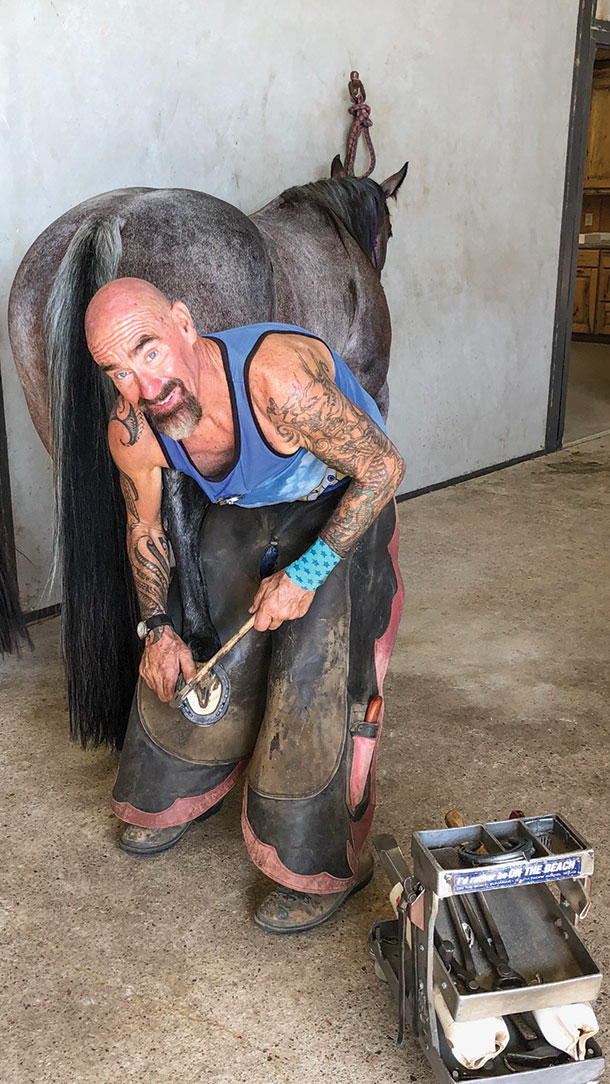
Some horse owners and ranchers shoe their own horses. For this task, they need to assemble an appropriate set of tools. Tommy Boudreau, certified farrier in Mineral Wells, Texas, says the worst place to get horseshoeing tools would be the local hardware or farm supply store. “You can use just about anything for pulling shoes off, but for trimming feet, invest in good nippers. They will last a long time and make your job easier,” he says.
Dean Moshier, an accredited professional farrier in Delaware, Ohio, says good nippers start at about $120, but you get what you pay for. “Top-end nippers will cost about 225 dollars. You’ll need a hefty, regular pair (not the thinner racetrack nipper), 14 or 15 inches in length. The short 12-inch nippers are for ponies, minis and foals,” he says.
A pulling tool of some sort is necessary, but Moshier prefers nail pullers to remove horseshoes because there’s no prying against a sensitive sole, and the shoe stays flat. “Prices range from 70 to 169 dollars for pull-offs and only about 64 to 113 dollars for nail pullers. Inexpensive pull-offs (or an old pair of cheap nippers) work, but a better quality nail-puller will last longer,” he explains.
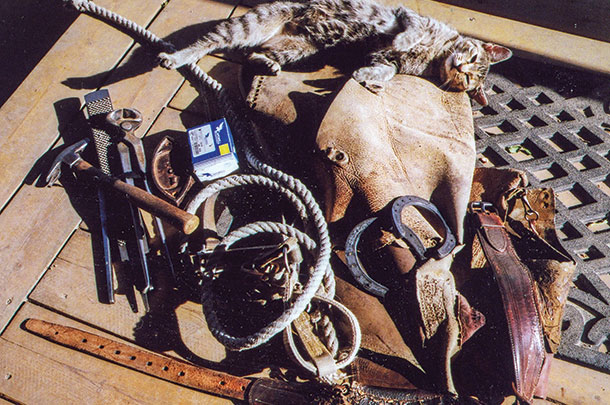
Boudreau says a good driving hammer makes your work more accurate and easier, and you can get one from a farrier supply store or order one online. “If you try to find tools at a farm store, you usually won’t get what you need. You are not shoeing as often as a professional farrier, so you need everything in your favor. It’s like trying to rope with a bad rope; you can’t get the job done very well,” he explains.
Moshier says a cheap hammer won’t have the proper angle or weight. “A modestly priced hammer might cost 50 to 70 dollars, with the most expensive ones up to 190 dollars. A good hammer will hold up for a lifetime. A heavier hammer won’t work any better and you’ll lose finesse and feel. A 10- to 12-ounce hammer has plenty of heft for the job.”
A rounding hammer is useful for shaping shoes, but when he was going to horseshoeing school, he used a regular mason’s or lineman’s hammer. “Those are modestly priced (about 30 dollars) versus a 200-dollar-plus rounding hammer, have a good weight (about 2.5 pounds) and hold up very well,” Moshier says.
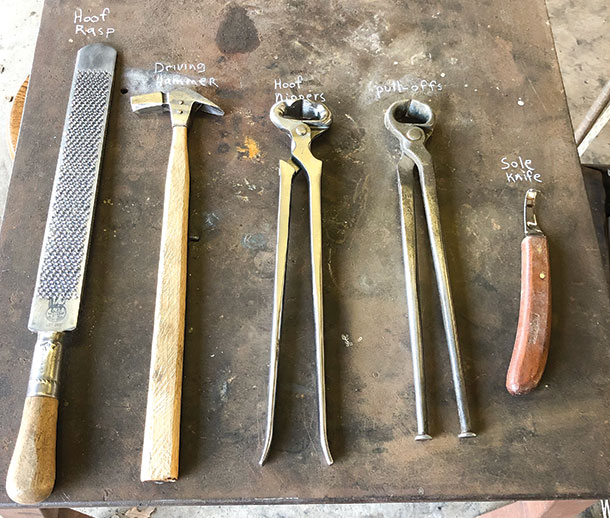
You’ll need a good hoof knife for trimming. “Find one that’s right- or left-handed to fit yourself,” says Boudreau. There are many types, and one style is as good as another – as long as it’s high quality and will stay sharp. Wrap it up when you’re not using it, so it won’t bump other tools and become dull.
“Expensive ones (100 dollars or more) hold an edge better, but also require better skills and equipment to sharpen,” says Moshier. “Cheaper knives (32 to 38 dollars) are more forgiving when you have to put a new edge on them, and might be adequate if you’re only shoeing occasionally.”
You also need a decent rasp. Don’t depend on a worn-out rasp that a farrier gave you. “Pay attention to tooth spacing,” says Moshier. “The wider the pattern, the easier it is to clean, and it may hold up longer.” Expect to pay about $25 for a rasp, and this is the tool that most frequently needs replaced.
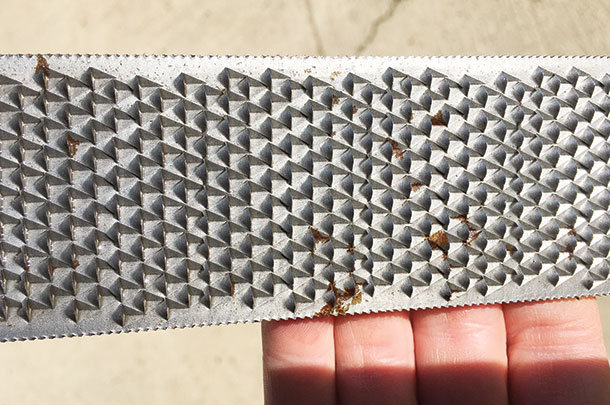
“Always keep an extra rasp on hand. Some rasps are coated with a protective layer to hinder oxidation,” he says. For clinching, you’ll need a second rasp; don’t use your trimming rasp or it will dull quicker. Buy a different type so you won’t grab the trimming rasp by mistake.
“The important thing is how you take care of a rasp,” says Boudreau. “Wrap it up or keep it in a piece of 2-inch PVC pipe or sandwich it between pieces of cardboard when you’re not using it, and don’t let it bump your other tools or it will dull.”
Moisture will rust and dull a rasp. Brush it off after use with a stiff wire brush and spray a little anti-rust lubricant on it before you put it away. “Even nippers can rust if they go a long time without use. Spray the rivets with WD-40,” says Boudreau. It pays to use a rust inhibitor on all metal tools, especially the rivets of any hinged tool or they may seize up to where they no longer function.
If you buy a clinching tool, get a good brand. “Cheap ones (about 48 dollars) wear out quickly, but you don’t need an expensive one (175 dollars or more),” says Moshier. “Most low-end (about 60 dollars) clinchers will be adequate, especially if you’re not doing a lot of horses. Clinchers are handy, as opposed to learning how to hammer clinch, and there’s less percussion against the hoof wall,” says Moshier.
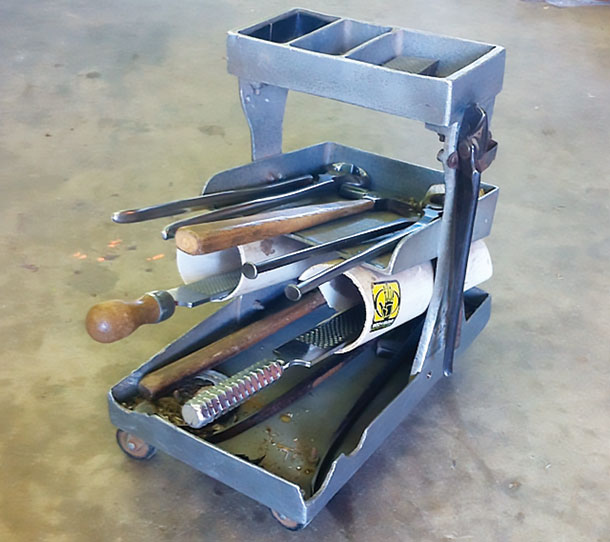
There are many kinds of toolboxes, and you don’t need something expensive. “My trim box is a grooming tote because it’s inexpensive (about 9 dollars), durable, light and easy to carry. If it gets broken, it can easily be replaced,” says Moshier. A wooden box for shoeing tools can be inexpensively made, with casters for rolling it around.
You can also use a bucket. When Boudreau had to fly somewhere to shoe horses and couldn’t take a shoeing box, he’d just put his tools in a 5-gallon bucket to carry from horse to horse when he got to the barns. “Everyone has a bucket. I shod quarter horse Triple Crown winner Dash for Speed out of a 5-gallon bucket during the 1980s at Ruidoso. I know you can shoe world champions out of a 5-gallon bucket!”
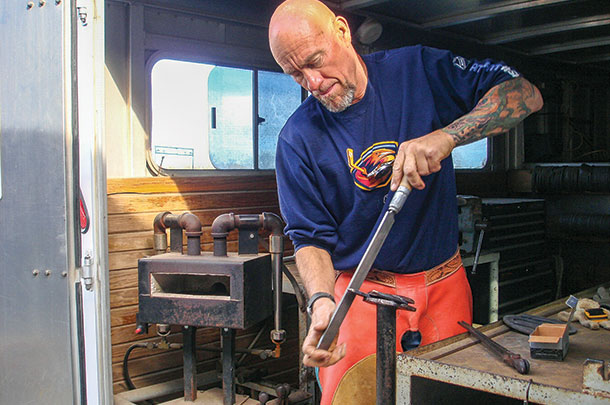
A small anvil is handy for shaping shoes. “A new 70-pound anvil may cost more than 500 dollars, but you can shop online or at a farrier-supply store for a used one,” says Moshier. “My first ‘anvil’ was a piece of railroad rail. A piece of I-beam also works. It enables you to spread and close shoes, but bending the branches or heels is easier using an anvil with heel-turning cams,” Moshier explains.
A stall jack or hoof stand is helpful to set the foot on when clinching nails. If you are just shoeing a few horses and don’t want to bother with a heavy anvil, a stall jack can be multipurpose. “It’s a three-legged tripod with a block of metal on top that can be used for shaping shoes,” Boudreau says.
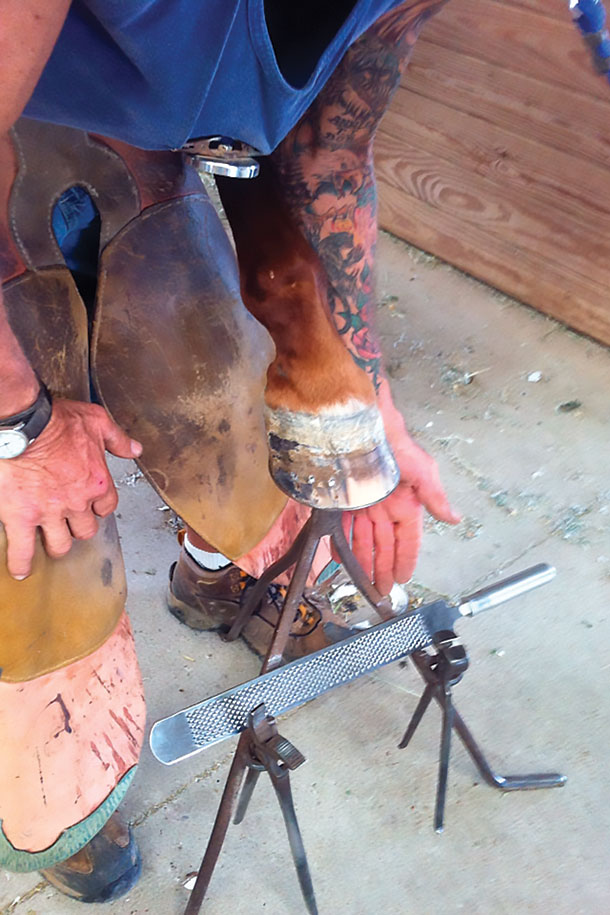
Moshier recommends a hoof jack-hoof cradle stand combination. “This will cost about 175 to 248 dollars. The cradle allows me to work more comfortably on the hind end of a horse,” he explains. “If you are only shoeing occasionally, your back and muscles are not in farrier shape, and you’re more apt to hurt your back. If you are not comfortable, the horse won’t be either, and a hoof cradle can really help,” he explains. An older horse with arthritis may be uncomfortable holding a hind leg up. A hoof jack-hoof cradle allows you to have that leg lower, and it won’t be as painful for the horse or for you.
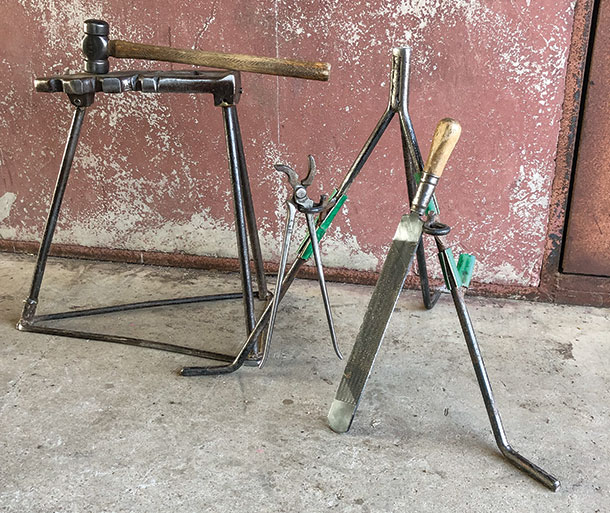
A shoeing apron protects your legs when nailing. Leather chaps or chinks will work, or you can buy a shoeing apron – or have your local saddlemaker make you one. “There are also canvas aprons that can be rolled up for storage, and you don’t have to worry about the leather aging or getting stiff,” Boudreau says. ![]()
PHOTO 1: Dean Moshier holds the simple grooming tote he uses for carrying his trimming tools. Photo provided by Dean Moshier.
PHOTO 2: Tommy Boudreau trims and shoes a horse. Photo provided by Tommy Boudreau.
PHOTO 3: This cat catches some rays on a farrier’s supply of tools, aided most of all by the warm leather chaps. Photo by Heather Thomas.
PHOTO 4: The basics tools include a rasp, hammer, nippers, pull-offs and hoof knife. Photo provided by Tommy Boudreau.
PHOTO 5: A trimming rasp starts to show rust spots after just three days of non-use. Photo provided by Dean Moshier.
PHOTO 6: A simple toolbox keeps tools organized. Photo provided by Tommy Boudreau.
PHOTO 7: Tommy Boudreau uses a file to put the finishing touches on a shoe he created. Photo provided by Tommy Boudreau.
PHOTO 8: A hoof stand with slots for holding your tools is very handy. Photo provided by Tommy Boudreau.
PHOTO 9: Some of the basic tools for trimming and shoeing. Photo provided by Tommy Boudreau.
Heather Thomas is a freelance writer based in Idaho.








